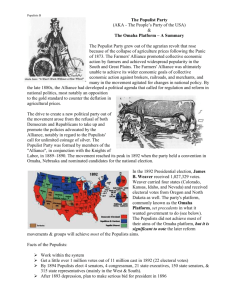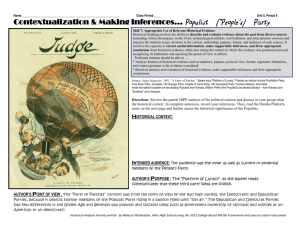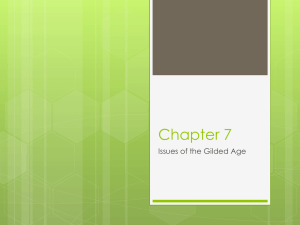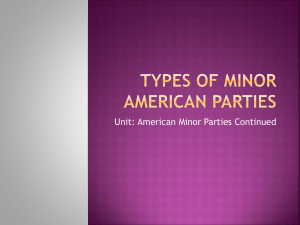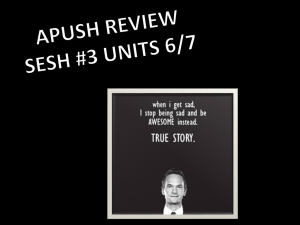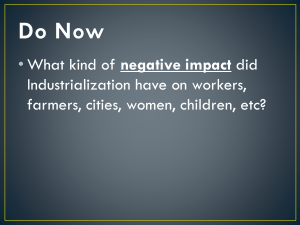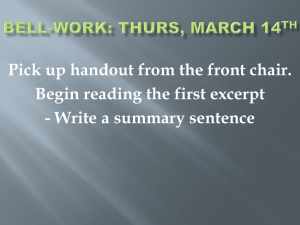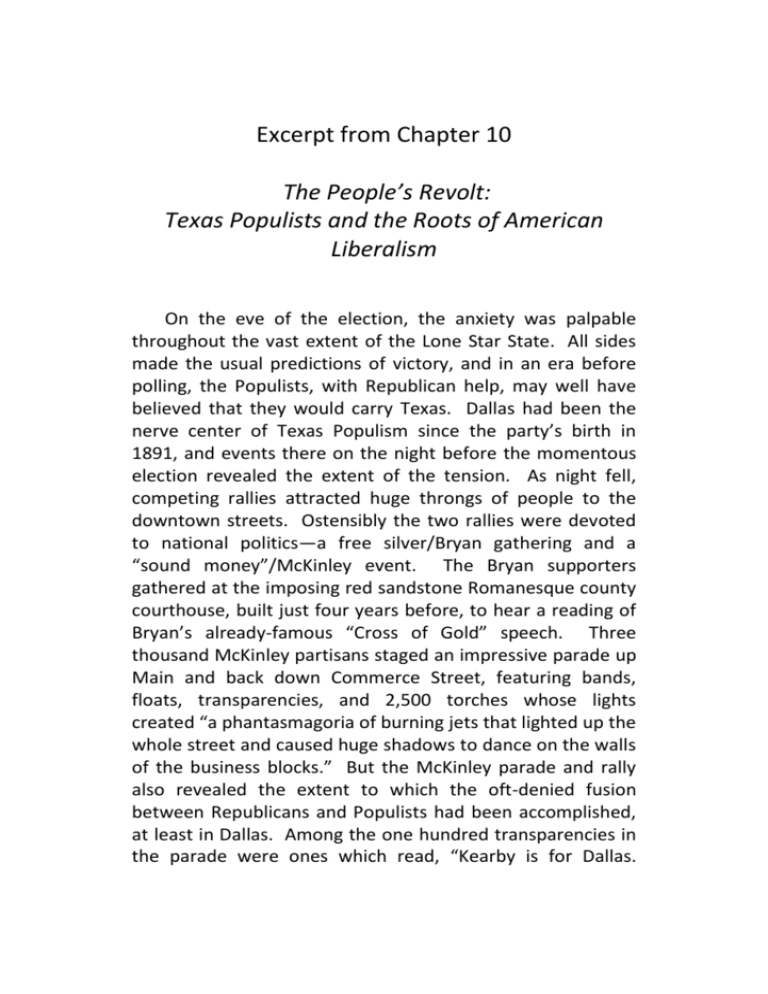
Excerpt from Chapter 10
The People’s Revolt:
Texas Populists and the Roots of American
Liberalism
On the eve of the election, the anxiety was palpable
throughout the vast extent of the Lone Star State. All sides
made the usual predictions of victory, and in an era before
polling, the Populists, with Republican help, may well have
believed that they would carry Texas. Dallas had been the
nerve center of Texas Populism since the party’s birth in
1891, and events there on the night before the momentous
election revealed the extent of the tension. As night fell,
competing rallies attracted huge throngs of people to the
downtown streets. Ostensibly the two rallies were devoted
to national politics—a free silver/Bryan gathering and a
“sound money”/McKinley event. The Bryan supporters
gathered at the imposing red sandstone Romanesque county
courthouse, built just four years before, to hear a reading of
Bryan’s already-famous “Cross of Gold” speech. Three
thousand McKinley partisans staged an impressive parade up
Main and back down Commerce Street, featuring bands,
floats, transparencies, and 2,500 torches whose lights
created “a phantasmagoria of burning jets that lighted up the
whole street and caused huge shadows to dance on the walls
of the business blocks.” But the McKinley parade and rally
also revealed the extent to which the oft-denied fusion
between Republicans and Populists had been accomplished,
at least in Dallas. Among the one hundred transparencies in
the parade were ones which read, “Kearby is for Dallas.
Dallas is for Kearby,” and “All Dallas for Gibbs independent of
politics.” The Dallas Morning News estimated that 20,000
spectators—fully half the city’s population—witnessed the
parade, and noted that “Men of all parties were well
represented. A populist jostled a sound money democrat
and a republican touched both.”
Arriving at a speaker’s stand, the crowd heard several
pro-McKinley speeches, after which “a thousand yells” went
up for Populist congressional nominee Barnett Gibbs, who
“was received with great applause.” Gibbs delivered his
speech, largely bypassing the obvious ideological differences
between Populists and Republicans, but as he finished a mob
from the Bryan rally arrived and raised such a din that
nothing from the speakers’ stand could be heard. One of the
rally’s organizers hastily assembled a band of men who
charged the mob, cracking a few heads and driving the
miscreants from the scene. Calls for Jerome Kearby
mounted, and after some delay, he appeared on the stage to
the sound of “terrific cheering and yells of welcome.”
Kearby’s impromptu speech revealed much about Texas
Populism. Referring to the mob that had disrupted the rally,
Kearby branded them as unpatriotic for their “attempts to
repress or suppress free speech.” He then turned to the
assembled throng and declared, “The men that I see before
me here to-night—white and black—are patriots.” And lest
anyone think that his reference to the biracial crowd was
gratuitous, he castigated the Democratic mob by saying,
“That gang of men out there are on a par with that class of
men that burn negroes at the stake,” a declaration that was
met with “great cheering.” “They constitute the ku klux and
the lawless bands of Texas.”
Needless to say, Kearby’s opponent, incumbent governor
Charles Culberson, did not stand before a throng of
Democrats that night and declare black Texans “patriots,”
nor did he denounce lynchers as “ku klux and the lawless
bands of Texas.” Whatever else Populism may have stood
for, whatever its shortcomings—and there were many—at its
best it at least recognized the fundamental right of all citizens
to life and a measure of common respect. On what would
prove to be the party’s final night as a political force in
America, Jerome Kearby represented Populism’s best.
The next morning, November 3, dawned fair and
pleasant across the state, with temperatures climbing into
the mid-seventies in most locales, a good sign for Populists
who needed their rural supporters to have dry roads for
wagon, buggy, or horseback trips to the polls. It was the last
good sign they would have that day, as it soon became clear
that the Democrats were taking no chances. Fraud is difficult
to document and nearly impossible to prove, especially given
the paucity of surviving Populist newspapers and
manuscripts, but the few extant sources suggest that it was
widespread. The experience of A.F. Nash, Populist nominee
for justice of the peace in his southeast Texas precinct,
probably was not unique. Nash told of appearing on the
streets of Crockett in Houston County to solicit votes and
being surrounded by “a mob of 75 or 100 of the toughs and
hoodlums,” incited by the local “rotten ring democracy.”
Rescued by the town marshal, he narrowly escaped being
ridden out of town on a rail or worse, choosing instead to
flee the town. “People may talk of a free country and a free
ballot,” he later bitterly complained, “but this does not look
like it.”
Not surprisingly, African American Populists faced the
most concerted, and the most deadly, efforts to deprive
them of their votes. Nowhere in Texas were they better
organized that in Robertson County, the home of John B.
Rayner in the rich cotton-growing district of the Brazos
Valley. There a coalition of Populists and Republicans had
elected candidates for years, including numerous blacks. On
election morning armed men began to arrive in the county
seat at Franklin, where they “quietly deposed” the black
town marshal before the polls opened. Forty men armed
with Winchester rifles then stationed themselves around the
courthouse, allowing only Democrats to enter to vote. A few
miles to the west, a company of black voters had assembled
in the Brazos bottoms with the intention of marching to
Hearne to cast their votes. Accompanied by a brass band,
they were accosted on the Little Brazos River bridge by an
armed posse of Democrats, which threw the instruments in
the river and dispersed the marchers. Meanwhile in Hearne
“a great number of pistol shots were fired in front of the
polls when the negroes from the bottom came in to vote,”
and as a consequence that box polled six hundred fewer
votes than in 1894. Elsewhere in the county, at one heavily
Populist box, the election judge reported that “a masked
man” took the box and the returns, presumably at gunpoint.
In another precinct the Democratic candidates for sheriff and
tax collector held off black voters with a gun and a club. At
mid-afternoon Democratic County Judge O.D. Cannon arrived
at the polls in his home precinct with his pistol in his hand. “I
went down to the polls and took my six-shooter,” he proudly
recalled years later. “I stayed there until the polls closed.
Not a negro voted. After that they didn’t any more in
Robertson County.” The details of of episodes like this
virtually never made it into the press. The Galveston Daily
News’s one line of coverage was typical: “Robertson county
seems to have out-Harrisoned Harrison county this year.”
Texans who followed politics knew precisely what that
meant.
More subtle tricks probably accounted for most of the
fraud. Among the most common was the manipulation of
ballots. Populists alleged that in Fort Bend and other blackmajority counties, ballots were handed to voters containing
the names of the Republican presidential electors and all of
the Populist state candidates, with the exception of the line
on the ticket where the governor’s name went. There
Democrat Charles Culberson’s name was inserted in place of
Kearby’s. Only the most careful voter was apt to notice the
deception, and illiterate voters stood little chance at all.
Jerome Kearby did as good a job as anyone at summarizing
the Democrats’ methods: "The moment the ring discovered
that there was danger they inaugurated a campaign of
slander, defamation, intimidation and fraud. The negro vote
in many sections was manipulated by fraud, intimidation and
open bribery; the ignorant were preyed upon by slander and
falsehood; the vicious and purchasable were hired by
campaign funds raised to debauch the elector. All manner of
devices to deceive, mislead and impose upon the voter were
resorted to on election day to compass the defeat of the
people’s party."
In the end it likely would not have mattered. When the
votes were counted, Kearby lost to Culberson by a vote of
298,528 to 238, 692, and the Democrats swept all statewide
offices. The Bryan-Sewall presidential ticket carried the state
with fifty-four percent of all votes cast, and no Populist
congressional candidate won, despite strong showings in five
districts. An estimated 40,000 of those who had supported
the Populists in 1894 returned to the Democrats, a swing of
80,000 votes, enough to cost Kearby the election. Despite
appeals to African American voters and Populist cooperation
with the state Republican leadership, estimates reveal that
the official black vote was almost evenly divided between the
Democrats and Populists. How many of those black votes
were stolen will never be known.
In the weeks and months to come Texas Populists would
struggle to come to terms with their loss. Many urged a
renewed effort to reorganize and reinvigorate the party,
arguing that Populists had learned a valuable lesson about
the evils of fusion, both on the national and state levels.
With Bryan decisively defeated, they believed that the
People’s Party could return to the “middle of the road” and
resume its crusade to bring a new vision of government to
America. But many other were not so sure. They knew that
the thousands who had followed Buck Walton back into the
ranks of the Democrats would never vote Populist again, and
the feeling that the Populist revolt was over was palpable.
Jerome Kearby no doubt expressed the feelings of many
when, six weeks after the election, he wrote, “The
opportunity was lost. I trust it may appear again; I fear not. I
can afford to speak freely, for I am done with politics.”
Copyright © 2015 David Gregg Cantrell. All Rights Reserved. Not to be
quoted, cited, or otherwise used without permission of the author.

